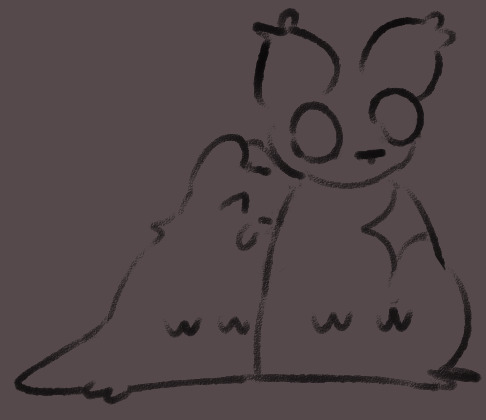#i should have been wacky with iterator designs earlier
Text
GGGGHJGHJGHFFFKKL Dust of Erased Limits and Clarity of Intent are hangign out
song - happy idiots by Gidropony
oc doodles under cut while we're at it










i need to kill them
okay fuck those guys its Mother and babys time




yaaaay !!!
#rain world#rain world oc#rw oc#oc#pmpwbrrs#i should have been wacky with iterator designs earlier#its soooo funnn#oc – Dust of Erased Limits#oc – Clarity of Intent#oc – Forbearance of Reciprocity#oc – Proud Indifference#oc – the Mother#oc – kiddos#holy shit it's almost all of them
132 notes
·
View notes
Text

my headcanon iterator designs! finally, in one place and rendered out nicely!!! get ready for the rambling under the cut i have many ideas
okay i love the simplistic design of rainworld creatures but i also love weird alien wacky designs so thats what i tried to go for here; a mix of strange alien bio-robots but aesthetically pleasing enough to look friendly. i think the iterator puppets arent the entirety of the iterator; they are also their can, of course, but the puppet is the "face" of the structure, as well as an important part of the biological aspect of iterators.
i think the puppets arent completely artificial. i think they are highly derived, highly modified purposed organisms made to fulfill a few requirements; be a friendly and relatable design for the citizens to be able to interact with the iterator, personify the iterator as a real living being and not just a box, and, most importantly, to house the biological brain that allows the supercomputer to be actually truly alive.
the brain inside the puppet is the part that gives the entire structure personality, intelligence, emotion, and everything else a biological brain can do that a computer cannot. almost the entirety of the brains ability to process information and think logically is outsourced to the structure via the umbilical wires. the neural cortex we see in game is the computer brain that is capable of all those calculations and simulations and all the amazing things iterators can. these two brains interact via the umbilical in a feedback loop of continuous information, working as one mind.
without the umbilical wire, the puppet is reduced to a normal beings brain; which is to say, they can speak and think, but lose access to their long term memory storage, their advanced logical processing power, and pretty much everything that makes them a god-like supercomputer. the only connection left in that case is through the neurons, which can interface between the puppet and structure as a lose tether of information(which is why moon is able to interact with her structure post rivulet even though the umbilical is still severed. the neurons each keep a copy of the iterators information to backup and pass though the structure, like a living usb, and moon can use them to access a smaller scale version of her former computational power).
the arm of the puppet acts both as a mobility device though low gravity and feeds nutrients to the puppet body as an outsourced digestive and circulatory system. the puppet itself does not have a complete digestive and circulatory system because of this.
i think the iterators should be like bugs, and so they are! they have a hard exoskeleton made of chitin and an open circulatory system. most of their interior is muscle and electronics to support the puppet's systems. various sensors to monitor health, gyroscopes to stay upright, electronics to read pearls and receive broadcasts (i think their antenna are both ears for sound and ears for electromagnetic waves). they have compound eyes for extremely good vision and a voice modulator allows them to speak.
one thing that always bothered me about the puppet design is that they have legs, and yet live in no gravity and are attached to a mobile arm. why would they need to walk? i decided that the people who built them decided to keep the legs for aesthetic reasons, but made them functionally useless. the legs are atrophied and could not actually support the puppet's weight. earlier generations, like moon, have more normal proportions and less atrophied legs; later generations get more and more stylized and streamlined, as we can see with pebble's more extreme proportions and extremely thin legs. you can also see a thick audio cable on the older models that pebbles doesnt have, and visible joints that are smoothly covered on pebbles.
the production of iterators may have been somewhat standardized, but we do know that different iterators can have different designs based on their creators taste. frankly, i love headcanoning NSH as being big and chunky while pebbles is a little twig. i plan to draw my interpretations for suns, inno, and wind too in the future.
so, yea! puppets! theyre fucked up and would struggle to survive detached from their structure completely because they are pugs and cannot survive outside of their domesticated lives.
10 notes
·
View notes
Text
Pepper Grinder Review - Short And Spicy - Game Informer
New Post has been published on https://thedigitalinsider.com/pepper-grinder-review-short-and-spicy-game-informer/
Pepper Grinder Review - Short And Spicy - Game Informer

Sometimes, all it takes to get started on a great game is to come up with a compelling mechanic, and Pepper Grinder is a prime example. The titular grinder is as powerful as it is versatile, able to drill through the ground and power all sorts of wacky devices. The difficulty curve can be choppy, and ends more quickly than it should, but that core mechanic builds a sturdy foundation that kept me entertained from start to finish.
That core mechanic is, of course, the Grinder, a conical drilling device protagonist Pepper uses to burrow through terrain, spin switches, and defeat enemies. Level design is consistently clever, and I won’t spoil anything, but I was impressed by the number of uses the team found for a device that could easily get old quickly. That said, while popping in and out of dirt patches, swinging on grappling hooks, and boosting over gaps is fun, it’s not as easy as it looks.

Don’t let Pepper Grinder’s pixel art and cheery exterior fool you – this game can get tough, particularly in its platforming challenges. Some jumps need to be boosted at just the right time, and if you’re not ready for a certain grapple point to appear, you plummet to your death. The hardest levels are Pepper Grinder’s boss stages, thrilling battles that make creative use of the game’s mechanics. Because bosses have large health bars, these are tests of endurance, but despite that, they manage to maintain the game’s blisteringly fast pace. The arenas and the bosses themselves also look fantastic, showcasing developer Ahr Ech’s talent for pixel art at the highest degree.
While I enjoy being challenged, the difficulty sometimes frustrated me with its inconsistency, with one level killing me repeatedly and the next one flying by without harming me once. Dying against a tough boss was never an issue because their difficulty is well-forecasted and fitting, but some levels have difficult jump sequences or waves of enemies right before a checkpoint, which annoyed me when I had to try again and again. While there are a few reasons this can happen, it’s at least partially a symptom of the game’s length; including fewer levels makes it harder to smooth out the difficulty curve, resulting in spikes like this.

I’ve alluded to it a few times, but Pepper Grinder is a surprisingly short experience. It only took me three and a half hours to complete the main story and then another half hour or so to go back and collect enough coins to play the locked levels I’d skipped over. I don’t mind short games, but rolling credits on this one caught me off guard. There are plenty of ideas and mechanics that could have easily been expanded, and by extending the earlier part of the game, the difficulty spikes near the end likely wouldn’t be as frustrating.
That said, I do appreciate its efficiency. Ahr Ech had an idea for a platforming mechanic and iterated on it just enough to complete a story – there’s not a wasted moment in the entire playthrough, and that’s more than a lot of games can say. Pepper Grinder is a well-cooked meal – I just wish the portion was bigger.

And there are ways to spend more time with the game after defeating the final boss. In addition to a time attack mode, completionists will be glad to see five collectible skull coins in each level, though they’re worth collecting for more casual players, too. With 10, you can access a locked level in each world, and they’re some of the most enjoyable levels in the entire game, sometimes even introducing completely new mechanics. Skull coins can also be used to unlock hair and clothing colors, but I wish they were separate – it feels odd to choose between playing more of the game and changing my hair color. I recommend prioritizing level unlocks, but I won’t blame you for springing for the pink hair.
Pepper Grinder is an innovative indie experience, packed with tense battles, fluid platforming, and eye-catching visual design. While its short runtime left me wanting more, I’m happy with what it is: a bright action platformer that’s anything but a grind.
#2024#Art#clothing#Color#colors#course#Design#Developer#devices#drill through#easy#efficiency#eye#Foundation#game#games#Health#Ideas#it#mechanics#mind#One#PC#pixel#platform#Play#power#review#talent#time
0 notes
Text
That Weird Little Hill Outside the Engineering Center
Class ends and everyone starts putting away their stuff. I sit there for a few moments even though my stuff is already put away, because I don’t want to be the first person to get up and leave the room because I feel guilty because I hadn’t been paying any attention. I would say that it’s funny, that I’m distracted by my phone even though the things in class are more interesting, at this point, than the things on my phone. Except it’s not that funny, but more importantly it’s kind of a fake comparison. It would be a fun little morality play to tell myself, to notice again how this desire for distraction becomes so extreme, so desperate, that it somehow becomes far more boring, at least in a sense, than it would be to just do the right thing. But that wouldn’t really be true, because the simpler explanation is just that I’m a little behind in class and I can’t really understand today’s lecture so of course I’m distracted.
Finally I pick up my backpack and put on my jacket and head through the door at the back of the classroom. I’m walking through the hallways and now looking again at my phone. It’s interesting, in fairness, I mean better-than-usual but also actually interesting. You see Blue Origin is a space company that wants to make reusable rockets – you’re thinking of SpaceX but they’re different, SpaceX makes the Falcon 9 and flies missions to orbit with real payloads but Blue Origin hasn’t done any of that yet, they’re still all research-and-development. They can afford to play the long game because the company is owned by Jeff Bezos, same guy who owns Amazon, and while they might both look like rich tech billionaires to the rest of us, Bezos has something like ten or twenty times more money than Elon, so he can fund all these rocket engines and test vehicles and all that just straight out-of-pocket, and doesn’t have to worry about closing the business case until later. Anyways Blue Origin has just announced some more details for their big new rocket, meaning like I mentioned the one that’s intended to start doing real business. It’s huge, of course, which is awesome, like half or two-thirds the size of a Saturn V, but everything is huge these days, it’s exciting. I can’t imagine how awful it must have been to be an aerospace engineer twenty or thirty years ago, when everything was always the same and if you were lucky you got to help shuffle shuttles around while you waited for the internet to get invented. But what’s really interesting about this new rocket, New Glenn they want to call it, isn’t the size, it’s the design. And what’s more interesting than the design is the approach. SpaceX like I said is already flying real missions, they made the rocket first – which for the record was a great rocket even before it could come back and land on a boat – and then they added everything else later, the reentry burns, the grid fins, the landing legs, very iterative, test test test. But perhaps as a side effect there was just a little a bit of opportunity cost there, because looking at New Glenn you can just tell, it just feels more polished, more cohesive, so obviously designed from the ground-up to be A Reusable Rocket, the way they have that aerodynamic shield around the engine and the landing legs that tuck so nicely into the body of the rocket and like wings, like huge fricking wings actually, with which apparently they’re going to glide for a really long time through the upper atmosphere, bleed off velocity, avoid a hot reentry that might damage the engines, plus no need for a boostback or reentry burn so that’s a massive amount of fuel saved which equals a whole lot more delta-V for the payload. Clever stuff, certainly, really interesting, but maybe it’s not all quite so great as it looks on paper. The Falcon 9 is already flying right now, for starters, and that means they’ve got all kinds of experience and they’ve had opportunities to work out all the bugs and they’ve been able to change the design of their rocket as they fly it, for instance to make it easier to manufacture or help it have a faster turn-around time for reusability, and you don’t get those advantages with the more secretive pre-planned Blue Origin approach.
I’ve just stepped outside the engineering center now and I switch to wondering whether I should walk home or try waiting for the bus. I think about this almost every time I leave the engineering center despite the fact that I almost invariably walk home instead of waiting for the bus. It’s odd because when I’m leaving my house and going to the engineering center, I take the bus pretty often, maybe even a little more than half of times. Why do my preferences change just because I’m coming versus going? Probably the main reason is that I’m rushing when I head to class but I’m not really in any rush when I’m going back the other way, and if you happen to catch it then the bus is obviously much faster than walking. Another thing that’s definitely true is that the bus to school always has room, wheras the bus from school is sometimes full with all the students who just got out of class, and of course the times when it’s mostly likely to be full are exactly the times when you most want to take the bus because so does everyone else, for instance when it’s snowy or icy or just cold and windy, and then you’ve waited all that time in the cold for nothing and you still have to walk. There are other factors, too, like when I leave from my apartment I can look down the road for a long way and see if the bus is coming, and pretty often if I see it’s coming I can run to make it to the stop in time, so there’s a bit of flexibility there, in a sense, I can also see how many people are at the stop and judge whether the bus just passed by and picked everyone else. It’s kind of hard to explain but having that information about where the bus is allows me to either wait for it or not wait for it in a more intelligent way than I can at school, where it’s more random and so on average I’ll end up waiting more. And then there’s other things, like there’s a big hill on the way to school and maybe secretly I hate going up the hill and that’s why I take the bus on the way there even though as far as I can tell I’m pretty sure I don’t mind going up the hill. Or maybe psychologically it’s easier to walk home and feels like a shorter trip but walking to school makes it a slog. But no matter how many good reasons I think of, the asymmetry still bothers me.
While I’m thinking about the bus I’m still looking at my phone; I never like having stuff running down the battery in the background so I tap to close the couple of tabs I was maybe gonna read and then double-click the home button and start swiping apps to close them. I click the screen off and put it in my pocket and then I pull my hood on and kind of jerk my shoulders to heft up my backpack so it’s more comfortable, and then I look up and up standing on the top of that one little grassy hill is just this girl.
It’s also night. The sky is dark deep-blue. The buildings around the college look very different at night, more like a city, a warm glow shining out through the little windows on the dormitories, streetlamps here and there full of sodium light. In front of the engineering center there’s this wacky little hill, maybe four feet high, very round, very green, all by itself, surrounded by like at least twenty feet of concrete on all sides. In the daytime when everyone’s going to class there are always tons of people walking around on the concrete, walking and parking their bikes and standing around talking to one another. But now it’s night and nobody’s here, there’s just one or two people walking across the campus, listening to music with their headphones in, and then this girl standing on top of the hill, looking kinda towards where the mountains would be, although for the most part you can’t see them behind the dormitory.
She’s a pure silhouette in the dark, but nevertheless I recognize the girl as Lakshmi, who I know from a group project we both worked on when we were in Fluid Dynamics last semester. She is the only person I know in the aerospace program who is Indian but not actually an international student, although she’s visited the country often enough to have fond childhood memories of Diwali in Udaipur where her aunt and uncle and grandparents live. I know this because it was around Halloween last semester when we were working on the group project, which was a bunch of Matlab code to simulate the motions of some weather balloons released inside a thunderstorm, and I mentioned how it’s funny that holidays from around the world can end up having some of the same qualities, and I wondered if maybe it had to do with being in the same part of the year, or possibly it’s coincidence because maybe there aren’t enough ways for holidays to be different from each other so they always end up sharing a couple of things. We talked about honeyed sweets from street vendors and firecracker celebrations in the little alleyways, and warm little candle flames glowing everywhere at night, like in a church.
I walk up on top of the hill next to her, and say “hi”. She says “hi” back. The grass is pretty soft; I can’t remember if I have actually walked on this hill before but I have definitely never stood on top of it. The whole engineering-center plaza looks the tiniest bit strange now, even though I’m only four feet higher up than normal.
Lakshmi is wearing a medium-length black dress; she must have been at that Lockheed Martin event earlier. I think, that must be cold, but then I realize that actually the night isn’t very cold. I take off my hood. There’s just the tiniest breeze that I can feel, and now in the corner of my eye I can see some trees, and their branches sway a little in the air, making a nice sound.
“Isn’t it funny,” she says, “how when you’re looking straight ahead, almost half of what you can see is sky, but nothing ever really happens in the sky? It’s very beautiful sometimes, but it’s almost never relevant to anything humans do. Half the world is just sky, and the other half is just the ground, and everything we think is interesting lives in a tiny little strip near the horizon.”
“That is funny,” I say.
“Even when it rains,” Lakshmi continues, “Even when it rains, you don’t look up to see that it’s raining. You can already tell by looking at the ground. So, there’s really no reason at all.”
I look up at the sky. The brighter stars are out by now. Venus is the brightest, low over the mountains, following the sun. Its gold light feels even more beautiful contrasted against the rich, deep blue of the western sky. Jupiter is higher up, its bright beige-pink light adding an extra jewel to the colorful reds and blues of the winter stars near Orion. There are no clouds. It’s dark and very quiet, except for the sway of the trees and the sound of the cars, far away.
“Isn’t it funny that there are all these dorms,” I start, “and there are all these undergraduate students who live in the dorms, and they have meal plans and eat at the cafeterias, and they go to class each day and in the evenings they go to all these campus events or go to parties, or maybe just sit in the common room with their friends and play videogames? And I’ve never once been inside any of these dorms, or eaten in any of the cafeterias, or any of that. It’s a whole different college.”
“Yes,” she responded, “They have all these Centers. Like the athletic center, the theater center, the music conservatory. Or that thing with the big flat roof they’re building over there.”
Lakshmi is pointing north, towards the stadium and, beyond it, downtown Boulder. I am intimately familiar with the dark outline of the gigantic building she is referring to, since I walk by it every day on the way home from class, but I have no idea what it contains.
“Sometimes I think I should go to some of those things, you know, all the college things. Just out of curiosity.” I say to her. “...But then I just start thinking about everything else I want to do, in the same way, just to see what’s there. Like, have you ever been for a hike in the flatirons?”
I point to some of the mountains peeking out from behind the left side of the dormitory. Even though it’s night, they are illuminated by a faint grey light. I can’t see the moon in the sky, but it must be up, probably hidden behind the engineering center.
“Do you mean those ones in particular, or..?”
“No, just in general.”
“Then yes, I’ve been.”
“When I was at Colorado College, which is in the Springs, it was a lot like here with a nice view of the mountains,” I say. “So every day, walking to class or eating dinner at one of the on-campus places, I would always be looking at these mountains. By senior year I’ve been looking at this beautiful vista for four years, and I know that Pikes Peak is one of the easiest mountains to climb – people literally drive to the top, there’s this dumb train and everything. So I’m like, obviously I have to climb it, how crazy would it be to look at something for four years and never be able to go there and look back? So I set off one weekend, and for the next two days everything I see is just completely unbelievable. Like, first off, once you climb the first little hill out of the town, there’s this massive valley before you get to the mountain. You spend the entire first day just walking through the forest – it’s high altitude but it’s not really part of the mountain, it’s not sloping upwards. It’s just, like, secret land. And I had had no idea it even existed, and there’s nothing there but forest, like it had been folded up. When I had always figured the mountain was more or less right there after the foothills. Then on the second day you actually climb the mountain, and in addition to being huge of course, it’s just so incredibly, like... three-dimensional.”
Lakshmi laughs. “Yes! Yes, I know what you mean,” she says. “Like that statue in Chicago.”
“Yeah! I just couldn’t believe my eyes, this thing I had stared at every day for four years had suddenly become totally curved and warped out, so in a way I had a better understanding of the real shape, of course, but it was also so gigantic, and so different, that I felt disoriented. And the view kept changing, of course, so eventually it felt like they were all, not wrong, but like... equidistant.”
“It’s so funny,” she said.
“Yeah.”
“You know what else is funny,” said Lakshmi, “There are so many things that we can’t think about. Or can-but-don’t, or maybe we can think about them, but not in a way that we can notice or not in a way that feels like thinking. And I don’t mean the sky, or the mountains, or anything even close to those things, because clearly we can think about those things, and in fact they are perfectly ordinary thoughts.”
As she said this, Lakshmi ran a hand through her hair, which was dark and straight and long, and then started doing some intricate thing, gathering up her hair into sections and passing them one over another. I watched her as she did this, and she continued with what she was saying:
“But it’s like those things. It’s like the sky and the horizon, and everything we can think about is on the horizon. Sometimes the horizon is really narrow, even more than usual, like... those glasses that are worn by the Inuit, in the snow. And then you can forget about almost everything else in the world, and all your thoughts are these loud, discrete things, like digital signals. Other times it’s better and the horizon opens up, and you can see much more and it feels like you can have all kinds of thoughts, all together. But it’s never, for instance... I mean, the whole sky is there the entire time. But even though it’s always there, it’s never the whole sky. There are so many parts of my life that I can’t say –”
“Yeah, and it’s not like they’re inaccessible,” I offer, “or like they’re out of reach...”
“No, certainly. It’s like – the whole concept is that we’re not wearing the snow-glasses, the whole sky is always there, it’s a part of me, but it’s as if it’s a part of me that isn’t part of me. Or something. It’s very strange. It makes me sad, when I think about it.”
Lakshmi summons a hair-tie and tilts her head sideways for a moment as she fixes the bun in place. I look down at the ground, and notice that I can see our two shadows stretched onto the plaza below the hill. I wheel around to catch sight of a nearly-full moon, which has just emerged from behind the engineering center. I watch the moon for a while, and I must not have heard the click of her shoes against the concrete, because when I turn back around she’s gone.
1 note
·
View note